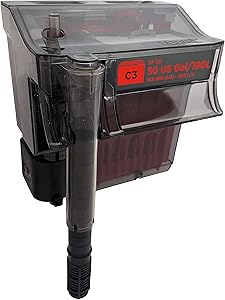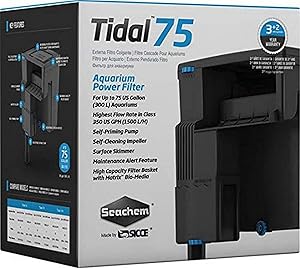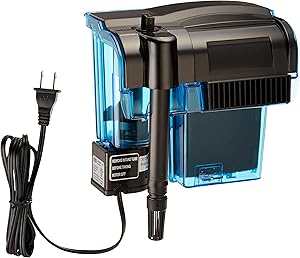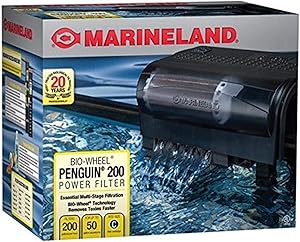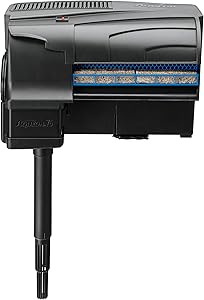Aquarium filtration is one of the key components required to keep an aquarium healthy and the water clear. The most common type of filter is the hang-on-back or HOB filter, which sits on the top rim of your tank and arches down the outside back. So, with this HOB filter design, only the intake tube is submerged.
The hang on the back (HOB) aquarium filter is the workhorse of the hobby and works for so many hobby fish tank setups.
HOB filters have been around for over 35 years, so the tech and design has been perfected. Early models tended to be noisy and not so reliable. But there’s been many new designs and upgrades over the years resulting in the refined filters we have today.
Here’s a close look at how external power filters work and an explanation of each model’s unique features.
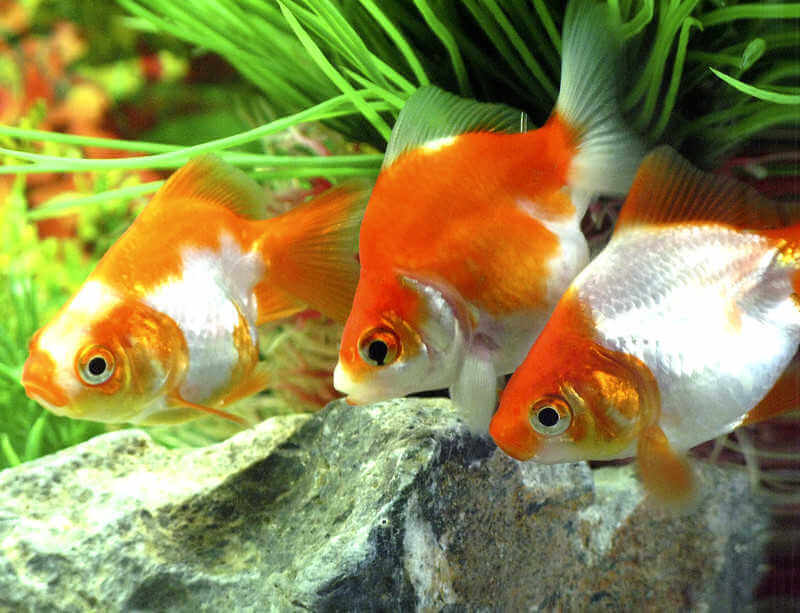
[toc]
Marineland Penguin Bio-Wheel Power Filter top pick for overall reliability, and the Fluval C Series for best filtration due to its multi chamber filtration design.
My Top Pick:
Best Rated HOB Filters Reviews
1. Hagen AquaClear
The AquaClear range of power filters has been around since 1978. Hagen is the world’s largest manufacturer of aquarium and pet supplies. Hagen is the inventor of the magnetic impeller design used in all HOB filters. It produced less heat, friction and wear that the original HOB design.
AquaClear filters have adjustable flow rates so you can turn down the flow when feeding your fish or working in the aquarium. AquaClear Power Filters provide all three types of filtration: mechanical, chemical, and biological. These filters use filtration inserts designed to fit into compartments or baskets within the filter.
Pros
- Comes with AquaClear foam, Activated Carbon and BioMax media
- Available for aquariums ranging from 5 to 110 US gallons
- Lots of space for your own filter media choices
Cons
- Filter has no leveling adjustment
The Fluval C power filter is another great option. The C Series has three different filter sizes C2 (30gal), C3 (50gal) and C4 (70gal). The price range is reasonably affordable ranging from $35 to $70.
Fluval C Series offers five stages of filtration water movement, adjusted by a slide lever to increase the amount of water flowing through the filter. The lip on the exit waterfall is decently wide, so on the max flow setting it definitely has an audible waterfall sound.
The filtrations system includes two types of mechanical filtration (foam and polyester pads) to trap the large debris. Next is the carbon filter pouch which is designed to help trap odors, discolorations and other impurities. Then the water passes down though a bio-screen trapping fine particles and into a chamber below which has ceramic-nodes which allows for the beneficial bacteria to grow and replenish your aquarium.
One excellent feature of the Fluval filter is each of these components can easily be removed for cleaning. Each of the foam filter pads, carbon pouch and ceramic-nodes can be replaced.
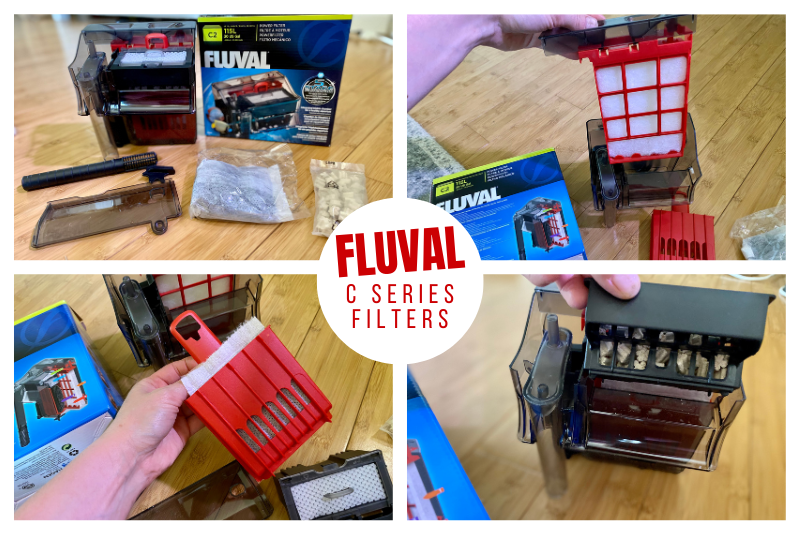
Let’s talk about aesthetic!
This is always an important ranking factor for me when selecting any equipment for my aquariums – it needs to look good. The Fluval C Series is a sleek design, featuring a combination of matte black durable plastics for the body and opaque black plastic on the top.
The waterfall lip creates a beautiful ‘spill’ effect too, with a pleasant soothing sound. The filter pump itself is quiet.

C2 Dimensions: 7″ x 5″ x 6″ (17.7 x 12.7 x 15.2 cm)
C3 Dimensions: 7″ x 5″ x 7″ (17.7 x 12.7 x 17.7 cm)
C4 Dimensions: 9″ x 6.5″ x 8.5″ (22.8 x 16.51 x 21.5 cm)
Pros
- Uses many stages of filter media
- Good flow rates for a variety of aquariums
- Three models for tanks up to 30 gallons to 70 gallons
- Can be used for freshwater & saltwater
- Has a red floating indicator that signals when to service the filter
- Affordable replacement filter pads, carbon pouch & ceramic-nodes
- Easily removable internal parts for cleaning
Cons
- Some filters develop noisy impellers after a few months
- Requires many types of replacement filter media
- Some internal components are made from red plastic (aesthetic con)
Buy The Fluval HOB Filter on Amazon
Seachem is best known for their water conditioners and filtration media. The Tidal power filters are a joint project between Seachem and Italian aquarium pump company Sicce.
The Tidal series has several unique features not found on other brands. The water pump is located inside the aquarium. This makes the filter self-priming. This configuration also helps quiet motor noise. The media is held in a one-piece filter basket inside the filter box. This makes it easy to remove all the media at one time. Just carry the basket to the sink.
Tidal power filters also have a surface skimmer feature that removes oily film and surface debris.
Pros
- Available models for 35-110-gallon tanks
- 5-year warranty
- Adjustable water flow
- Quiet operation
Cons
- Flow rate must be turned down when a lot of media is used
- Cleaning indicator reacts too quickly
Tetra has been making aquarium filters for over 30 years. The Whisper EX is supposed to be an upgrade to the original Whisper filter.
There is nothing complicated with this HOB design. The replaceable filter cartridge is loaded into a plastic frame. The frame slides into the filter box. The cartridge provides mechanical and carbon filtration. When dirty, just pull out the frame, squeeze the frame and the old filter falls out. No need to touch a dirty cartridge.
The Whisper EX also has a plastic insert to provide extra surface area for biological filtration. This bio-filter component never needs to be replaced. The pump is positioned inside the aquarium making the EX series self-priming.
Pros
- Simple filter design
- Easy to clean and maintain
Cons
- Noisy impeller
- High incidence of motor failure
The Penn Plax Cascade power filter is an economy filter popular with freshwater aquarists. It uses a simple drop-in cartridge that captures debris and adsorbs colors and odors. The Bio-Falls component is a plastic insert that channels some water flow over zig-zag shaped fins. This is supposed to provide surface area for bacteria.
The sponge block is also said to enhance biological filtration and remove particles. Flow rate is adjustable. The uplift tube slides up and down in case you need to adjust its length.
Pros
- Simple design
- Available in a range of aquariums up to 100 gallons
- 3-year warranty
Cons
- Low flow rate
- Questionable reliability of the water pump
The Marineland Bio-Wheel design is based on rotating biological wastewater filters. The idea is to rotate the partially submerged Bio-wheel in the water stream, maximizing aeration for the bacteria growing on the wheel. Since nearly all of the beneficial bacteria live on the gravel and in the water, the Bio-Wheel is more of an accessory than essential component of the filter.
The Penguin uses a basic HOB design to pump water through a filter cartridge. The filter cartridge uses a high-grade activated carbon and a fine-mesh filter pad sealed onto a rigid plastic frame. The Penguin does not have a flow control to reduce the flow rate.
Pros
- Quiet motor
- Dependable operation of the impeller.
- Solid construction
- Excellent filter cartridges
Cons
- Noticeable trickling water noise from Bio-Wheel
- Bio-wheel stops spinning when it gets dirty
- No flow control
7. Aqueon QuietFlow LED Pro
The Aqueon company was formed by a group of aquarium industry veterans that wanted to start their own product line of aquarium products. The QuietFlow filters have undergone several changes over the years.
The current LED Pro model features a self-priming water pump for easy set-up and automatic restarting. It also has a red LED indicator light on the lid. The LED turns on when the water inside the filter rises, due to clogging.
The filter cartridges provide mechanical, chemical, biological filtration plus additional purification with the Aqueon specialty filter pads for ammonia and phosphate removal. The removable plastic grid is said to add extra surface area for beneficial bacteria. The filter range covers aquariums from 20 through 45-gallon aquariums
Pros
- Quiet operation
- Easy to set-up and clean
- High-quality filter cartridges
- Lifetime warranty
Cons
- False positive LED signals
- No flow control
Early aquarium filtration
Before the invention of the hang on the back power filter, aquarists used an air-powered submersible filter known as a “corner” or “bubble-up filter”. The design consisted of a clear plastic box filled with activated carbon and polyester fiber. It was placed in the corner of the tank.
An external air pump sent air down into the filter box, causing bubbles to rise through an uplift tube. The rising bubbles pulled aquarium water into the filter box, through the filter media and out the uplift tube.
The design worked well but had several undesirable qualities. The filter box took up room inside the aquarium. Since it was clear, you could see the media along with the dirty polyester fiber. Back then air pumps were rather noisy. The constant hum of the air pump coupled with the “burping” sound of large bubbles flowing from the filter became the trademark sound of an aquarium.
While the filters were effective, maintenance was always messy. To service the filter, you had to reach into the aquarium, remove the filter, disconnect it from the air line and carry it to the sink. The slimy filter material was removed by hand.
Next came the refilling of the filter box. The typical method was to sandwich loose activated carbon in between layers of polyester fiber. It was difficult to purge the air trapped in the polyester. This sometimes caused the filter box to float to the surface of the water. It could be very frustrating. The invention of the power filter changed everything!
The invention of the power filter
Instead of placing the filter box inside the aquarium, HOB filters are external filters. The filter box hangs on the back of the tank. Rather that rely on an air pump, HOB filters use an electric water pump. That’s why HOB filters are also known as “external power filters”.
Early models still used loose granular activated carbon sandwiched in between layers of polyester. An electric water pump kept water flowing through the media and out to the tank.
The filter was maintained by taking it to the sink for washing and refilling with fresh media. Aquarists no longer had stick their arm into the aquarium and the filter didn’t take up valuable space inside the tank. The electric pump could make noise in not seated correctly against the filter box. If the electric went off, even briefly, the pump impeller might not restart. The new filter was quite an advancement in the hobby, but it needed refinement.
Modern hang on the back aquarium filters
Today’s HOB filters are much more reliable and easier to use. The water pump is smaller and more efficient. The pump motor is attached directly to the filter box, eliminating most of the rattles and vibration. Improved impeller configuration is quieter and more reliable that early designs. The filter will automatically restart if there is a power failure.
The sum of all these innovations have transformed the noisy external power filter into a quiet, energy-efficient filtration system that can be used in any room of the house or office without calling attention to itself. But there’s more.
Today’s HOB filters feature ready-to-use filter cartridges. Designs vary, but filter cartridges consist of outer layers of polyester fabric to remove particulate matter with activated carbon sandwiched in between. The carbon removes water discoloration and odors cause by dissolved organic compounds. The filter cartridges slip into the filter box. When the cartridge gets dirty, just pull it out and pop in a new one. No messy filter clean-outs!
Where to install the filter
As the name implies, HOB filters hang on the top edge of the aquarium. Nearly all aquarists place the filter on the back of the aquarium. This keeps the filter out of sight.
It’s important to make sure there is enough room behind the aquarium for the filter to fit. Some filter designs are larger than others and require more space between the wall and the aquarium.
If you are using a plastic aquarium hood and light, you will most likely have to trim away part of your plastic to make room for the filter. Most name-brand aquarium hoods have special cut-out areas on the back on the light. These are designed to make it easy to snap off a section of plastic so the filter will fit on the tank.
Another common design uses a removable plastic filler strip. Simply mark the filler strip, trim it with scissors and slip it back in place. Now your filter will slide onto the back of the aquarium.
If you’re using an open top aquarium you can place it anywhere on the tank. Some aquarists put the filter on the side of the aquarium. They like the side to side water flow pattern it creates.
Assembling the power filter
Hang on the back power filters range from very simple to very complex designs.
Read the manual to become familiar with the components of the filter. Check the parts list to be sure you have everything you need before starting the installation. That way you can return or exchange the filter right away if something is missing.
Your filter may have a leveling tab on the bottom of the filter box. The tab allows you to change the tilt of the filter so it’s level. If the filter is tilting backwards, it could cause water to splash over the back of the filter box.
Make sure the pump and impeller are seated correctly. Eventually you’ll have to clean these so it’s a good idea to take a close look now before the installation.
Check the routing of the power cord. You want to form a drip loop as described in the set-up guide. The drip loop prevents water from flowing down the power cord and into the outlet. If water makes its way into the outlet it will cause a short and trip the breaker. It could even start a fire. Check your filter manual to learn how to create a drip loop!
Starting up a hang on the back filter
Once assembled and placed on the aquarium, add water to the filter box until it overflows into the aquarium. Your tank should also be filled with water, to the top of the tank.
Filling the filter with water is called priming (Some filter designs are self-priming and don’t need to be filled with water at start-up). Now plug in the power cord. The filter will probably make a brief grinding noise as the impeller starts. This is normal.
You may hear whooshing sounds and see a lot of bubbles pour into the aquarium. This happens as the filter flushes air out of the system. The pump may even have a little bit of noise as it breaks in. This can take an hour or so. Don’t panic.
Now is a good time to look inside the filter box and see how the water flows through the system. You’ll see how water enters the filter through the uplift tube, passes through the pump and flows back into the aquarium by gravity.
Next, slip the filter cartridge into the filter. Notice how water passes through the cartridge and into the aquarium. As the filter get dirty it will be harder for water to pass through. This will cause the water level in the filter box to rise.
This is why it is so important to make sure the filter is level and not tilting backwards. If it is tilted backwards water may be able to slosh over the back, wetting the floor and causing damage.
Maintaining your aquarium filter
In order to keep your filter performing at peak efficiency it will require periodic maintenance. It does not matter if it is a tiny HOB for a nano tank or a giant multi-cartridge system for a large aquarium.
Every time you feed your fish, make sure the intake screen is free of debris like plant leaves and algae. A clogged intake screen won’t allow water to enter the filter. But never run the filter without the screen. Fish can get sucked into the filter and be killed. Even a large fish can become trapped against the suction of the pump.
Without the intake screen snails and other debris can jam the impeller and stop the impeller from turning. Eventually the filter will develop a layer of biological slime on the impeller and magnet. The slime will create drag on the impeller and reduce efficiency.
Every six months remove the impeller and clean it with a small brush. Some aquarists use this as an opportunity to scrub out the entire filter. Take the filter to the sink and remove the uplift tube and intake screen. Clean every surface with a paper town or small brush. Ordinary water works fine for cleaning the filter.
The uplift tube can be challenge to clean. One method involves pushing a piece of paper towel through the tube with a pencil. Consider a special uplift tube brush if you find the paper towel method difficult.
When to change the filter cartridge
The most common type of HOB filter media is the filter cartridge. The cartridge consists of porous polyester material attached to a rigid plastic frame. The frame keeps the polyester material in the proper shape and keeps it from collapsing under the pressure caused by flowing water. Many cartridges also have activated carbon inside.
New cartridges are very porous and not able to trap much debris. But eventually a biofilm coats the fibers and reducing the spaces in between the poly fibers. This makes the cartridge better able to capture tiny bits of particulate matter. This efficiency-improving coating is known as “filter cake” in the industrial water filtration world.
A “mature” filter can capture fine particles that pass right through a fresh filter cartridge. It takes about a week for the new cartridge to mature. It may even turn brow of look dirty. This is normal.
But after about 30 to 45 days the cartridge becomes clogged. Water can’t pass through it, so it bypasses the cartridge and flows back into the tank. Many aquarists think because water continues to circulate the cartridge is still active. The truth is the aquarium water is not being filtered at all once the cartridge is clogged with debris and slime.
HOBs are designed to allow water bypass in case of a clogged cartridge. If the cartridge includes activated carbon, it will function for about three to four weeks at most. If you want your aquarium to remain clear and clean, you must change the cartridge every month or even sooner if it gets really dirty.
A word about advanced external power filters
Some brands of power filters have very complex designs. They may use foam blocks for particulate removal and a bag of activated carbon for adsorption of organics. Some designs even have biological media to enhance removal of ammonia and nitrite.
These filters are more complicated to assemble and will take more time to service and maintain. Keep the instruction manual in a safe place. You’ll probably have to refer to it when changing the filter media and reassembling the filter after cleaning.
Even though these HOB filters boast more advanced water purification, they still require new media about every 30 days.
HOB filters and planted aquariums
If you’re raising live aquatic plants a HOB filter is a great filter choice.
With a planted aquarium the focus is on growing plants, not packing the tank with fish. Much of the particulate waste found in a heavily stocked community tank won’t occur in a planted aquarium. It’s much easier to keep the water sparkling clear since the plants act as a giant biological filter that removes algae-promoting nutrients, helping to keep the tank balanced and healthy.
Plants need moderate water flow and HOB will move the water nicely.
HOB filters and saltwater tanks
Some aquarists wonder if a HOB power filter is suitable for a saltwater aquarium. HOB filters provide removal of suspended debris (mechanical filtration) and adsorption of dissolved organics (chemical filtration) that discolor the water, cause odors and reduce water quality.
HOB filters have been used on small saltwater fish and reef aquariums for over 25 years. Today’s all-in-one nano reef tanks are based on the same principles of filtration.
An HOB won’t provide a chamber to place a protein skimmer. But you can add an internal protein skimmer if you need one.
HOB vs canister filters
Aquarists struggling to properly care for an over-stocked or over-fed aquarium frequently think a bigger filter is the answer to their problems.
The root cause of cloudy water, high ammonia and nitrite and sick fish is rarely lack of filtration. It’s a misunderstanding of how to properly care for their fish.
HOB and canister filters use the same basic approach to removing suspended particles and organics.
Canister filters are just larger and able to hold greater quantities of filtration media. You can even use biological filter media in both types of filter.
So, the question is not which one is better. It really comes down to which one is larger. Do you really need more water flow and more filter media? If the answer is no, then there is no need for a larger canister filter. You may want one and that’s OK. You’ll have more flow, more options on routing the intake and return lines and more room for filter media. But you’ll also have a little more work when it comes time to change the filter media.
Recommended hang on the back filters
The topic of HOB power filters is highly subjective. A model that is well-liked by one aquarist may not be favored by another.
The main concerns are quietness and reliability. The truth is, these filters are mass-produced by the thousands. Some manufacturers buy “off the shelf” models and put their name on the box. Other companies engineer and fine-tune their own design with custom features. Reliability of the motor and pump depends on the quality control standards maintained by each company. Filter cartridges range from poor to excellent, depending on the brand.
Based on this knowledge and over 25 years of using these HOB filters I can recommend the following models:
Marineland Penguin Bio-Wheel Power Filters
The Marineland filter line has been in the hobby for well over 25 years. The design has proven to be reliable and effective for freshwater and marine aquariums. The fit and finish of the filter range is very good. The filter box is made of thick, high-quality plastic. The filter cartridges are excellent quality.
While the importance of the Bio-Wheel for biological filtration is questionable, it provides a fun rotating extra biofilter that creates a gentle splash of water. If you don’t like the splashing sound, just remove the Bio-wheel and enjoy the silent operation.
Fluval C Power Filters
If you’re the kind of aquarists that loves sophistication, the Fluval C series is sure to satisfy. The multi-component design provides a variety of filtration options for your saltwater or planted aquarium.
This is not a simple filter and will require more time to maintain and clean. But it gives you a lot of options for customization and has a variety of filter media to choose from.
Seachem Tidal Power Filters
The Tidal line of filters provides the Italian water pump quality of Sicce combined with a unique filter design. The goal of aquarium filtration is to pass water through media. The Tidal filter does that with its large removable media basket.
The filter basket makes it easy to use an array of filter media of your choice. You’re not locked into using the filter manufacturer’s cartridge or carbon. The filter is quiet and self-priming too.
I’d use this filter on any type of aquarium since I get to choose the filter media and it’s easy to clean and maintain.
Final thoughts
It seems like no matter the brand or model, sometimes HOB filters make a little noise. If your HOB filter is making a humming sound, remove the lid and see if it quiets down. If it does, try using a piece of adhesive tape to lock the lid onto the filter box.
Sometimes the quiet vibration of the motor gets amplified through the filter box. This energy causes the lid to vibrate, causing an annoying hum. The tape should help reduce the noise. If the impeller is making a clicking noise, try reseating the motor and impeller. Often that’s all that is needed to quiet down the motor.
If you have questions or comments, please leave them below!



